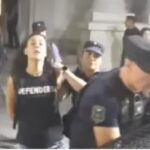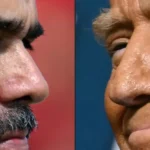
In the last round of conversations in Istanbul, the delegations of Russia and Ukraine have exchanged their memoranda to end the war, documents in which they put black on white on their conditions and their proposal of a road map to sign a peace agreement that ends the conflict initiated by the invasion of Vladimir Putin in February 2022.
At Monday there was no progress towards a truce and the positions are still far away in the process that has gained impulse under the pressure of Donald Trump. While kyiv emphasizes the total and unconditional fire before sitting down to negotiate peace with the Russian counterpart, Moscow conditions the end of the fighting to two options that seem impossible to the invaded country: or the complete withdrawal of Ukraine of the regions of Donetsk, Lugansk, Zaporiyia and Jersón, which Russia partially occupies (approximately 80%) A broad list of requirements that include the end of all Western military aid, limits to the size of the army and demobilization. Putin also requires Ukraine to put an end to martial law and celebrate elections before signing an agreement.
kyiv has said that he will study for a few days the Russian memorandum, that many experts believe that it is equivalent to a capitulation, before deciding the measures to be taken.
Next, we publish the texts of the Documents of Ukraine and Russia in full, as we collect both western media and Russian state agencies (eldiario.es does not intervene in the content):
I. Key principles of the agreement and the negotiation process
– Alto the total and unconditional fire in the sky, the earth and the sea as a necessary antecedent and previous requirement for the peace negotiations.
– Trust promotion measures – address humanitarian issues: unconditional return of all deported and illegally displaced Ukrainian children. Exchange of all prisoners (principle of “all for all”). Russian release of all civil hostages.
– No repetition of aggression: the objective of negotiations is to restore a permanent basis for lasting peace and security and ensure that aggression is not repeated.
– Safety and commitment guarantees of the international community: Ukraine must receive solid security guarantees. The parties will invite the international community to participate in the negotiations and to provide guarantees to ensure the application of the agreements.
– Sovereignty: Ukraine is not obliged to be neutral. You can choose to be part of the Euro -Atlantic community and move towards adhesion to the EU. The entry of Ukraine into NATO depends on the consensus within the Alliance. Restrictions may not be imposed on the number, deployment or other parameters of the Ukrainian Armed Forces, as well as the deployment of troops of foreign states friends in the territory of Ukraine.
– Territorial issues: the territorial advances achieved by Russia since February 2014 are not recognized by the international community. The contact line is the starting point of the negotiations. Territorial issues are only discussed after a total and unconditional fire.
– Sanctions: some sanctions can be raised to Russia, but in stages and only gradually, with a mechanism to resume sanctions if necessary (snapback). Frozed Russian sovereign assets are used for reconstruction or remain frozen until compensation is paid.
– Application: Agree a clear, balanced and attainable road map for the application and compliance with the agreements.
II. Next step: Agree the Fire and the Agenda of the Leaders Meeting
– After the Istanbul meeting, the parties will continue the conversations, which will focus on: (1) the high total and unconditional fire: its modalities and its supervision; (2) The measures to promote trust; (3) Prepare, agree on the agenda and the structure of future negotiations of leaders on key issues.
– The negotiations will be held with the participation of the United States and Europe.
III. Cease-fire
– Total and unconditional fire in heaven, earth and sea for at least 30 days (with the possibility of renewable extensions every 30 days) as a necessary background and prerequisite for peace negotiations.
– Supervision of Alto El Fuego, directed by the US and supported by third countries
IV. Trust promotion measures
– After the success of the exchange of prisoners of war after the Conversations of Istanbul, the parties continue the process of exchange of all prisoners of war (“all of all” principle).
– Agreement on the unconditional return by Russia of all deported and displaced Ukrainian children, and Russian release of all civil prisoners. These measures should include all categories of people listed, since February 2014.
V. Meeting of leaders
– The leaders of Ukraine and Russia meet to agree on the key aspects of the final peace agreement.
– Key themes of the peace agreement that leaders must agree on:
1) Permanent and complete cessation of hostilities: conditions, supervision, sanctions for violations.
2) Security guarantees and not repetition of aggression.
3) Territorial issues.
4) Economy, compensation, reconstruction.
5) Sanctions for breach of the agreements.
6) Celebration of a definitive peace agreement.
Section I. Key parameters of the final agreement
– International recognition of the incorporation of the regions of Crimea, the Popular Republic of Lugansk, the Popular Republic of Donetsk, Zaporiyia and Jersón to the Russian Federation: complete withdrawal of the Ukrainian army and other Ukrainian paramilitary formations of the territories.
– Neutrality of Ukraine, which implies its refusal to join military alliances and coalitions, the prohibition of any military activity of third countries in the territory of Ukraine and the deployment of foreign military formations, military bases and military infrastructure there.
– Confirmation of the status of Ukraine as a state that does not have nuclear weapons or mass destruction. Prohibition of reception, traffic and deployment of nuclear weapons in Ukraine.
– Establishment of a maximum number of troops from the Armed Forces of Ukraine, weapons and military team. Nationalist formations within the army must dissolve.
– Ensure all the rights, freedoms and interests of the Russian and Russian population. Grant the Russian language official status.
– Legal prohibition of glorification and propaganda of Nazism and neo -Nazism.
– All current sanctions imposed by Ukraine against the Russian Federation will be lifted and the new ones will be abandoned.
– Address a series of issues related to family reunification and displaced persons.
– Give mutual compensation for damages caused by military actions.
– Lifting the restrictions to the Ukrainian Orthodox Church.
– Gradual restoration of diplomatic and economic relations with Ukraine, including gas traffic.
Section II. Terms of Alto El Fuego
– Beginning of the complete withdrawal of the Ukrainian army of the Russian territories, including the Popular Republic of Lugansk, the Popular Republic of Donetsk, Zaporiyia and Jersón, at an agreed distance from the Russian border.
- Option 2. “Package proposal”.
– Prohibition of the Redesploin of the Armed Forces of Ukraine, with the exception of the movements to withdraw at an agreed distance from the borders of the Russian Federation.
– Cake mobilization and begin demobilization of Ukraine.
– Cesar the supply of foreign weapons to Ukraine, including the supply of intelligence data.
– Exclude the military presence of third countries in the territory of Ukraine and stop the participation of foreign specialists in military operations on the side of Ukraine.
– GUkrainian Aranties to refrain from sabotage and subversive activities against Russia and its citizens.
– Create a bilateral monitoring and control center of the high fire regime.
– Amnesty of the “political prisoners” and freeing the civilians detained.
– Lifting of martial law by kyiv.
– Announcement of the date of the presidential and parliamentary elections within 100 days of the lifting of the martial law.
– Signature of the agreement on what is contained in Section I.
Section III. Sequence of steps and deadlines for implementation
– Start working on the text of the agreement.
– Declare a fire of two to three days to collect the bodies in the “Gray Zone”.
– Transfer of 6,000 bodies of deceased military to the Ukrainian part.
– Signature of the memorandum with specific dates.
– The 30 -day fire will begin after the withdrawal of the Ukraine Armed Forces. During this period, all the “agreement package” must be met.
– Celebration of elections, formation of government organs in the territory of Ukraine.
– Signature of the agreement.
– Approval through a legally binding resolution of the UN Security Council.
– Ratification and entry into force of the treaty.
“Russia is still determined to demand the total capitulation of Ukraine”
For the analyst Tatiana Stanovaya, the part of the Russian document in which he addresses the high to fire is an “hypocritical.” “Ostensibly two options: or kyiv retires from the annexed regions, or passes directly to the second option, more developed, which in fact guarantees that Ukraine cannot resume any military activity, repeals the martial law and celebrates presidential elections.” “In simple terms, Moscow knows that the first option is not viable and tries to push kyiv towards the second as the main route. But it also means – and this is important – that Russia is open to consider the possibility of leaving Ukraine parts of the annexed regions that it does not control.”
However, he adds, there are nuances. “With the second option, Ukraine would have no possibility to resume fighting. It should also be noted that the first option, although apparently beneficial for Russia, is actually less preferable than the second, since it does not address the key issue: Western military aid. They simply do not believe it is politically feasible, and I think they are right.”
For the experts of the Institute for the Study of War (ISW, in English), the Moscow memorandum reflects the public demands that Kremlin has been expressing for a long time for Ukraine to “carry out significant territorial and political concessions, while Russia offers none”. “We continue to consider that Russia is still determined to demand no less than the total capitulation of Ukraine and that Russia will continue to pursue this goal while Putin believes that Russia can defeat Ukraine militarily,” they say in their latest report.
Source: www.eldiario.es

